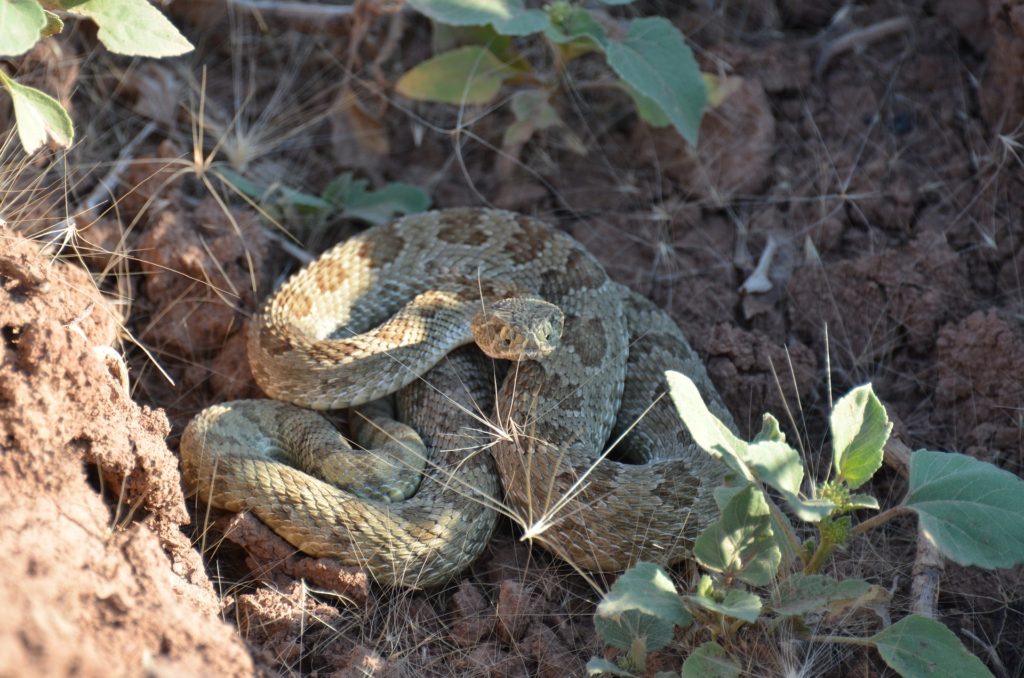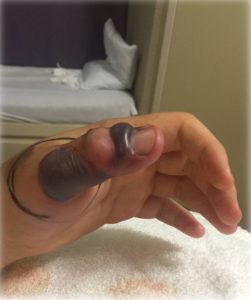How Common Are Snake Attacks in Oklahoma?

Residents across Oklahoma watched a terrifying video that went viral last week when a doorbell camera captured a large snake biting an unsuspecting Lawton man directly in the face.
The video shows Jerel Heywood opening a screen door when suddenly a snake leaps into the video and bites Heywood’s head. He then shouts, “Take me to the hospital! I just got bit by a snake!”
Luckily for Heywood, the bull snake that bit him was not poisonous. But just how common are snakes in Oklahoma? How poisonous are they? Should you be worried that one might be lurking in your mailbox?
“Not really,” says Dr. William Banner, who specializes in pediatric critical care and toxicology at INTEGRIS Health. “This type of attack is very rare.” In fact, Dr. Banner thinks the snake attacked because it felt threatened. He also doesn’t think the snake was seeking shelter in the mailbox, but rather someone placed the snake there.
Although snake bites in Oklahoma are rare, they still happen. Last year, the Oklahoma Center for Poison & Drug Information reported about 300 snake bites in Oklahoma.
Unfortunately, some of those bites were poisonous. According to Dr. Colby Edwards, who works in the emergency department at INTEGRIS Health Edmond, “The most common poisonous snake bites we see here in the Edmond ER are copperheads. We also see venomous bites from cottonmouths/water moccasins and rattlesnakes.”
But perhaps you don’t need to worry too much — out of 47 snake species in Oklahoma, only seven are venomous.
Poisonous or not, getting bitten by a snake is undoubtedly unpleasant. Now that we’ve moved into warmer weather, we’re heading into prime snake season, which spikes in late August. It’s a good time to review some important things to know about the types of snakes in Oklahoma and their dangers, so you can keep your family safe this summer when you’re enjoying the great outdoors while camping, hiking or going to the lake.

Identifying venomous snakes in Oklahoma
There are several things to look for on a snake that can help identify if it is venomous.
- The first is its head shape. Typically, venomous snakes have heads that are diamond or triangular in shape.
- Venomous snakes also have pits on each side of the head between the nostril and the eyes.
- The shape of the snake's eyes can also be a giveaway. If the eyes have vertical pupils (like cat eyes) it’s a strong indicator the snake is poisonous.
Types of venomous snakes in Oklahoma
Cottonmouth/Water Moccasins. This snake is large and has a black mark that runs from its eye to the corner of its mouth. A cottonmouth can also be identified when it opens its jaws wide, revealing its distinctive white flesh.
Rattlesnakes. Rattlesnakes make up the majority of venomous snakes in Oklahoma and can be identified by the rattlers on their tails, which they shake vigorously at threats. There are several types of rattlesnakes found in Oklahoma, including Prairie Rattlesnakes, Western Diamondback Rattlesnakes, Western Pigmy Rattlesnakes, Timber Rattlesnakes and Western Massasauga Rattlesnakes.
Copperheads. This snake is small and usually has brown, peachy or tan mottled skin.

Where are venomous snakes found in Oklahoma?
Cottonmouths, copperheads, massasaugas and pigmy rattlesnakes are usually found in moist areas. Many people mistake ordinary water snakes for cottonmouths or copperheads when fishing or swimming. From a distance, you can see that non-venomous water snakes only swim with the upper halves of their body out of the water. Regardless, it’s best just to steer clear.
Other venomous snakes are found near prairies and in southern and western Oklahoma where rocky ridges are common. A rocky terrain is a prime place for these southwestern snakes to warm in the sun.
Non-venomous snakes in Oklahoma
Compared to venomous snakes, non-venomous snakes tend to have small and narrow shaped heads. These include:
- water snakes
- garter snakes
- king snakes
- rat snakes
- bull snakes
- milk snakes
- green snakes
- mud snakes
- blind snakes
Garter snakes, rat snakes and king snakes can be found in various terrains, including damp woodlands, meadows, prairies and farms. Their prey includes rodents, small mammals, frogs and lizards. If you own chickens, king snakes are frequently found near the coop trying to steal eggs.
How to avoid snakes
No doubt, we all hope to never bump into a snake, and there are things you can do to lower your chances. For example, in wooded areas, be sure to look before you reach! When spending time outdoors in areas where snakes might be, it’s a good idea to wear tall boots and long pants. Other tips to avoid snakes include:
- Always keep a keen eye and stay aware of your foot placement, especially in high grass, wooded areas and rocky terrain.
- The best way to avoid snakes is to walk on clear paths, free of debris.
- You can reduce the chance of running into a snake around your home by removing tall grass, brush piles and piled materials.
- Try to seal any cracks in foundations, windows, doors and air conditioners to help prevent them from entering your home.
How to deal with a snake bite
Here are some tips from Dr. Banner on dealing with a snake bite. Remember to remain calm to keep the heart rate down, and try and keep the bite site below heart level. Don’t try and catch the snake, and never try to ‘suck out the venom.’
“When dealing with a snake bite at home, try your best to leave the bite alone. Be sure to never cut, puncture, tourniquet or ice your wound,” Dr. Banner says. “The best thing you can do is move to a safe place, monitor your heart rate and breathing, note the time of the bite so it can be reported, and get to the emergency room as soon as possible.”
Once you're in the hospital, treatment may include the use of anti-venom, lab work, pain sedation medications and supportive care.
Facts from the doctor
- The well-known rhyme “Red touch black, safe for Jack. Red touch yellow, kills a fellow” does not apply in Oklahoma! If you see a bright red and yellow snake, it’s best to get out of the way as quickly as possible, rather than looking at each stripe.
- It is a myth that snakes are more dangerous in springtime because they have stronger venom.
- If you text "poison" to 797979 you will get a contact number sent to your phone for the poison control center, or you can call 1-800-222-1222.
Use this information to help you and your family better prepare for the upcoming snake season in Oklahoma. Keep in mind how to correctly identify venomous and non-venomous snakes, stay aware of your surroundings and take proper action if a snake bite occurs.

